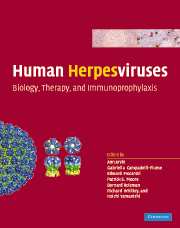Book contents
- Frontmatter
- Contents
- List of contributors
- Preface
- Part I Introduction: definition and classification of the human herpesviruses
- Part II Basic virology and viral gene effects on host cell functions: alphaherpesviruses
- Part II Basic virology and viral gene effects on host cell functions: betaherpesviruses
- Part II Basic virology and viral gene effects on host cell functions: gammaherpesviruses
- Part III Pathogenesis, clinical disease, host response, and epidemiology: HSV-1 and HSV-2
- 32 HSV-1 AND 2: Pathogenesis and disease
- 33 HSV-1 and 2: molecular basis of HSV latency and reactivation
- 34 HSV-1 and 2: immunobiology and host response
- 35 HSV: immunopathological aspects of HSV infection
- 36 HSV: persistence in the population: epidemiology, transmission
- Part III Pathogenesis, clinical disease, host response, and epidemiology: VZU
- Part III Pathogenesis, clinical disease, host response, and epidemiology: HCMV
- Part III Pathogenesis, clinical disease, host response, and epidemiology: HHV- 6A, 6B, and 7
- Part III Pathogenesis, clinical disease, host response, and epidemiology: gammaherpesviruses
- Part IV Non-human primate herpesviruses
- Part V Subversion of adaptive immunity
- Part VI Antiviral therapy
- Part VII Vaccines and immunothgerapy
- Part VIII Herpes as therapeutic agents
- Index
- Plate section
- References
34 - HSV-1 and 2: immunobiology and host response
from Part III - Pathogenesis, clinical disease, host response, and epidemiology: HSV-1 and HSV-2
Published online by Cambridge University Press: 24 December 2009
- Frontmatter
- Contents
- List of contributors
- Preface
- Part I Introduction: definition and classification of the human herpesviruses
- Part II Basic virology and viral gene effects on host cell functions: alphaherpesviruses
- Part II Basic virology and viral gene effects on host cell functions: betaherpesviruses
- Part II Basic virology and viral gene effects on host cell functions: gammaherpesviruses
- Part III Pathogenesis, clinical disease, host response, and epidemiology: HSV-1 and HSV-2
- 32 HSV-1 AND 2: Pathogenesis and disease
- 33 HSV-1 and 2: molecular basis of HSV latency and reactivation
- 34 HSV-1 and 2: immunobiology and host response
- 35 HSV: immunopathological aspects of HSV infection
- 36 HSV: persistence in the population: epidemiology, transmission
- Part III Pathogenesis, clinical disease, host response, and epidemiology: VZU
- Part III Pathogenesis, clinical disease, host response, and epidemiology: HCMV
- Part III Pathogenesis, clinical disease, host response, and epidemiology: HHV- 6A, 6B, and 7
- Part III Pathogenesis, clinical disease, host response, and epidemiology: gammaherpesviruses
- Part IV Non-human primate herpesviruses
- Part V Subversion of adaptive immunity
- Part VI Antiviral therapy
- Part VII Vaccines and immunothgerapy
- Part VIII Herpes as therapeutic agents
- Index
- Plate section
- References
Summary
Introduction
Herpesviruses began to evolve prior to the development of acquired immunity (Arzul et al., 2002). It is therefore likely that evasion of innate immunity is an ancient function of alphaherpesviruses. Additional immune evasion functions have developed to adapt to the diverse repertoires of B- and T-cell immune receptors that characterize acquired immunity (Roizman and Pellet, 2001; Littman et al., 1999). Immune evasion is covered in detail elsewhere in this volume. The innate and acquired immune responses to HSV are relevant to preventative and therapeutic vaccines for HSV, HSV-induced immunopathology, and the use of modified HSV for gene or cancer therapy. While human studies are, of necessity, observational or ex vivo in nature and seldom access sites of neuronal latency, we review them in detail because of their medical relevance. The excellent tools available for murine studies, including exquisite control of the DNA sequence of HSV challenge strains, and of the phenotype and genotype of recipient animals, are yielding dramatic new insights as well. Reactivation of HSV from neuronal latency is less frequent in mice than in humans, limiting immunologic studies of this challenging phenomenon. Readers are referred to excellent reviews (Schmid and Rouse, 1992; Nash, 2000; Lopez et al., 1993, Simmons et al., 1992; Kohl,1992) for models and materials that cannot be covered in detail.
HSV interactions with dendritic cells
Dendritic cells (DC) are a major link between innate and acquired immunity. DC are mobile cells that can potently initiate acquired immunity.
- Type
- Chapter
- Information
- Human HerpesvirusesBiology, Therapy, and Immunoprophylaxis, pp. 616 - 641Publisher: Cambridge University PressPrint publication year: 2007
References
- 1
- Cited by

